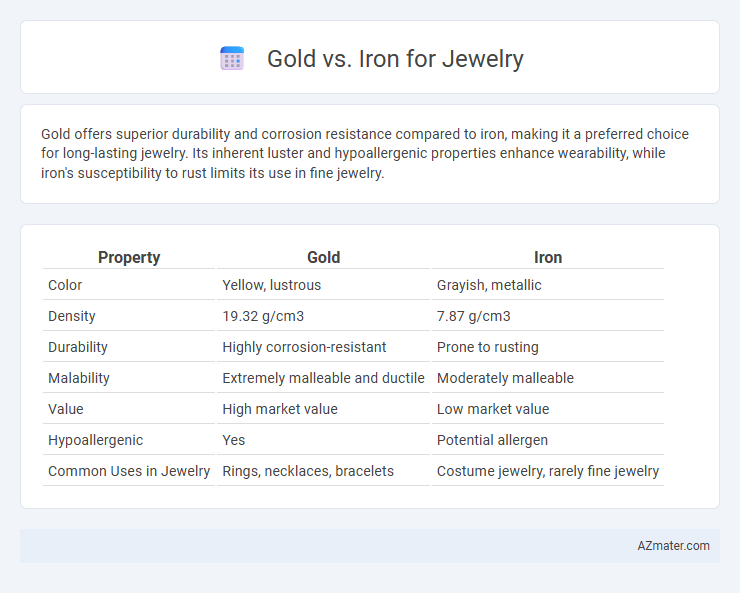Gold offers superior durability and corrosion resistance compared to iron, making it a preferred choice for long-lasting jewelry. Its inherent luster and hypoallergenic properties enhance wearability, while iron's susceptibility to rust limits its use in fine jewelry.
Table of Comparison
| Property | Gold | Iron |
|---|---|---|
| Color | Yellow, lustrous | Grayish, metallic |
| Density | 19.32 g/cm3 | 7.87 g/cm3 |
| Durability | Highly corrosion-resistant | Prone to rusting |
| Malability | Extremely malleable and ductile | Moderately malleable |
| Value | High market value | Low market value |
| Hypoallergenic | Yes | Potential allergen |
| Common Uses in Jewelry | Rings, necklaces, bracelets | Costume jewelry, rarely fine jewelry |
Introduction to Gold and Iron in Jewelry
Gold is prized in jewelry for its natural luster, malleability, and resistance to tarnish, making it ideal for intricate designs and long-lasting pieces. Iron, less common in jewelry, offers durability and a distinct industrial aesthetic but requires protective coatings to prevent rust and corrosion. The choice between gold and iron hinges on desired elegance versus ruggedness, with gold being the preferred metal for luxury and traditional jewelry.
Historical Significance of Gold and Iron Jewelry
Gold jewelry has symbolized wealth, power, and divine connection across ancient civilizations such as Egypt, Mesopotamia, and the Indus Valley, often used in royal regalia and religious artifacts. Iron jewelry, originating later in history, represents resilience and practicality, with significant cultural importance in African and Celtic societies where it symbolized strength and protection. The historical significance of gold lies in its rarity and lustrous permanence, while iron's value comes from its accessibility and symbolic association with human advancement through metallurgy.
Physical Properties: Gold vs Iron
Gold exhibits high malleability and corrosion resistance, making it ideal for intricate jewelry designs that withstand tarnishing over time. Iron is harder and more durable but prone to rust and oxidation, requiring protective coatings in jewelry applications. The density of gold (19.32 g/cm3) surpasses iron (7.87 g/cm3), giving gold jewelry a heavier, more luxurious feel compared to iron's lightweight and utilitarian nature.
Aesthetic Appeal and Design Possibilities
Gold jewelry offers a timeless aesthetic appeal with its warm, lustrous glow that enhances intricate designs and complements a wide range of gemstones. Iron, though less common, provides a unique industrial charm with its dark, matte finish and is often used in modern, minimalist, or avant-garde jewelry designs, benefiting from its malleability and durability. The choice between gold and iron significantly influences design possibilities, where gold supports delicate filigree and ornate patterns, while iron excels in bold, structural, and contemporary pieces.
Durability and Longevity Comparison
Gold, known for its resistance to tarnish and corrosion, offers exceptional durability and maintains its luster over time, making it a preferred choice for long-lasting jewelry. Iron, while strong and hard, is prone to rust and oxidation, which significantly diminishes its longevity unless carefully coated or treated. The inherent properties of gold, including its malleability blended with alloying metals, provide a superior balance of durability and aesthetic appeal compared to iron in jewelry applications.
Hypoallergenic Qualities: Skin Sensitivity
Gold jewelry, particularly 14k and 18k varieties, exhibits excellent hypoallergenic qualities, making it suitable for individuals with sensitive skin. Iron jewelry often contains alloys or coatings that can trigger allergic reactions or skin irritation due to nickel or other metal impurities. Choosing high-purity gold minimizes the risk of dermatological issues, ensuring comfort and safety for users with metal sensitivities.
Maintenance and Care for Gold vs Iron Jewelry
Gold jewelry requires minimal maintenance due to its resistance to tarnish and corrosion, making it ideal for daily wear with occasional gentle cleaning using mild soap and water. Iron jewelry demands more frequent care, including protection from moisture and regular application of anti-rust treatments to prevent oxidation and discoloration. Proper storage in dry environments and using soft cloths for polishing can extend the longevity of both gold and iron pieces.
Cost and Investment Value
Gold jewelry typically carries a higher cost due to its intrinsic value, rarity, and demand in global markets, making it a popular choice for long-term investment. Iron, being abundant and significantly less expensive, is generally used for fashion jewelry rather than investment purposes. Investors favor gold for its historical stability, liquidity, and ability to hedge against inflation, while iron lacks these financial benefits.
Popular Trends in Gold and Iron Jewelry
Gold jewelry continues to dominate popular trends due to its classic appeal, durability, and versatility in designs, often seen in yellow, white, and rose gold variations. Iron jewelry is gaining attention for its industrial aesthetic and affordability, appealing to consumers seeking unique, modern, and rugged accessories. The rising trend in mixing metals combines gold's luxury with iron's edgy vibe, creating bold, contemporary pieces favored in fashion-forward markets.
Choosing the Right Metal for Your Style
Gold jewelry offers timeless elegance, with options like yellow, white, and rose gold providing versatility to match classic or modern styles. Iron jewelry, often found in stainless steel variants, emphasizes durability and a contemporary, industrial aesthetic suited for bold, minimalist looks. Selecting the right metal depends on personal style preferences, skin sensitivity, and desired maintenance level, with gold prized for its luxury and warmth, while iron appeals for strength and affordability.

Infographic: Gold vs Iron for Jewelry
 azmater.com
azmater.com